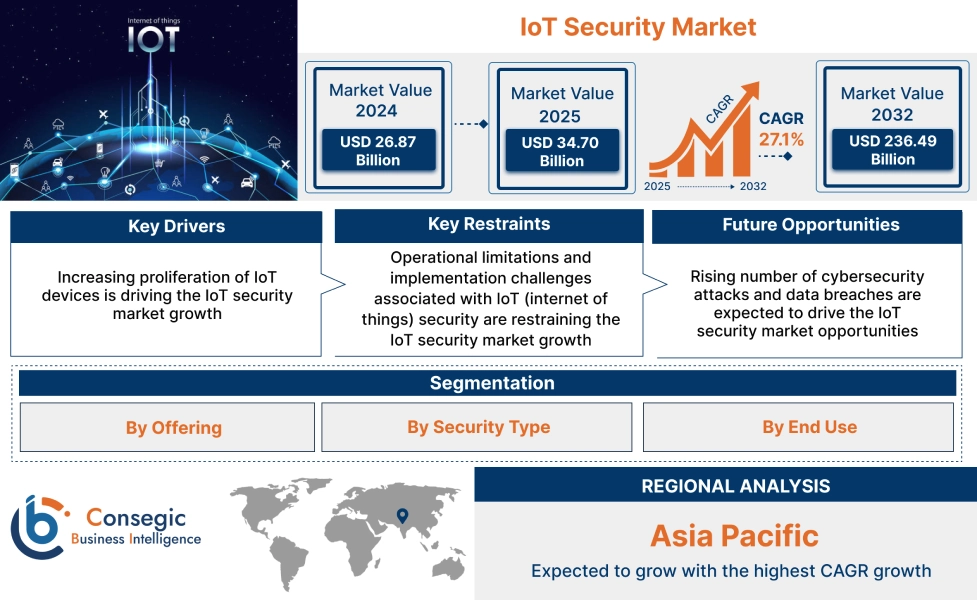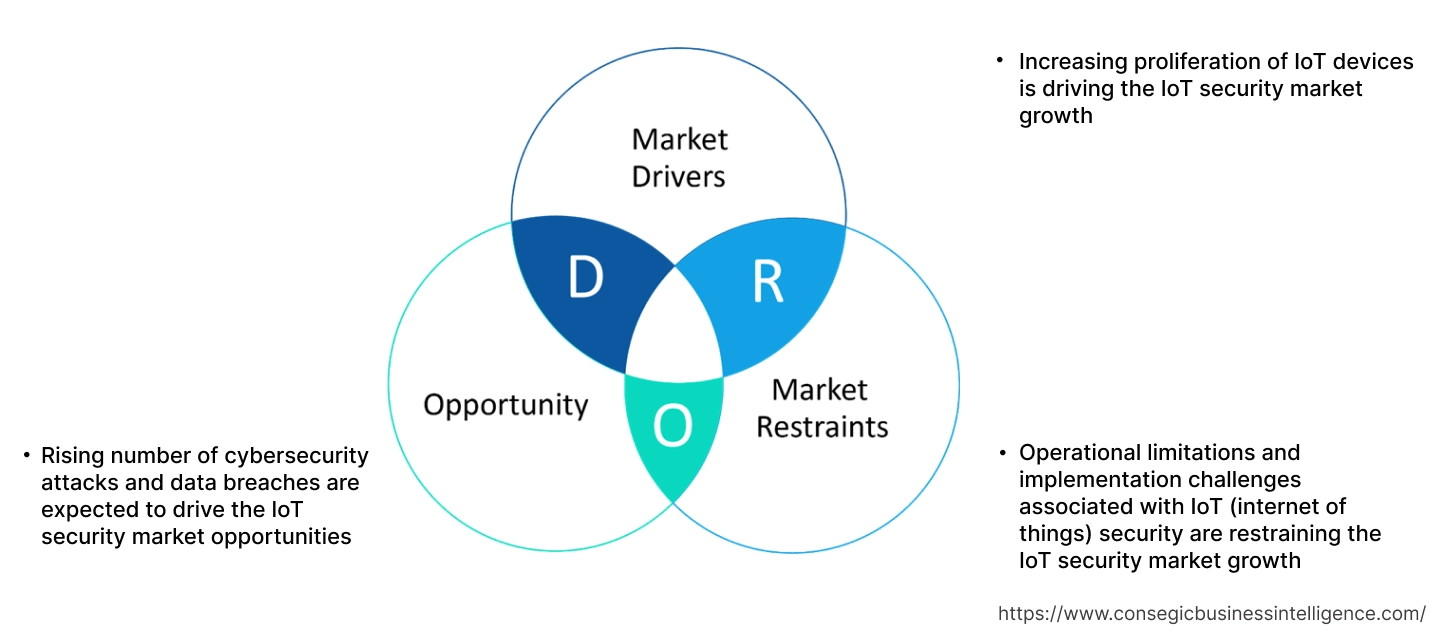IoT Security Market Size:
IoT Security Market size is estimated to reach over USD 236.49 Billion by 2032 from a value of USD 26.87 Billion in 2024 and is projected to grow by USD 34.70 Billion in 2025, growing at a CAGR of 27.1% from 2025 to 2032.
IoT Security Market Scope & Overview:
IoT (internet of things) primarily focuses on protecting internet-connected devices and networks they use from cyber threats. It involves securing devices, networks, and data to ensure privacy, confidentiality, and proper functioning of the IoT ecosystem. Moreover, IoT security offers several benefits, including comprehensive security, enhanced data protection, improved privacy, increased operational efficiency, and others. Additionally, the rising proliferation of IoT devices, ranging from smart home appliances to industrial equipment, is increasing the demand for robust security measures to mitigate risks such as data breaches, malware, and unauthorized access, which is further driving the market.
How is AI Transforming the IoT Security Market?
AI is playing a crucial role in strengthening the IoT security market by enabling real-time threat detection, faster response, and smarter risk management. With the growing number of connected devices, AI helps monitor massive data streams to identify unusual behavior or potential breaches. It enhances anomaly detection, automates threat analysis, and supports predictive security, reducing the risk of cyberattacks. AI also improves device authentication and access control, ensuring secure communication across IoT networks. As IoT systems become more complex and vulnerable, AI-driven security solutions offer scalable protection, adapt to evolving threats, and reduce the need for manual oversight. This makes AI essential for securing the future of connected ecosystems.
IoT Security Market Dynamics - (DRO) :
Key Drivers:
Increasing proliferation of IoT devices is driving the IoT security market growth
There is a rapid proliferation of IoT devices across numerous sectors, including smart homes, healthcare, industrial automation, and others. As more devices connect to the internet, there is a rising need for robust security solutions to protect these devices and the data they generate from cyber threats. Moreover, IoT devices often handle sensitive data, making data breaches and unauthorized access a major concern. As a result, the rising proliferation of IoT devices is increasing the demand for IoT security solutions, thereby driving the market.
- For instance, the total number of IoT devices worldwide reached 17.7 billion in 2024, witnessing a substantial increase from 15.7 billion in 2023 and 13.8 billion in 2022, respectively.
Thus, according to the analysis, the increasing proliferation of IoT devices is driving the demand for advanced security solutions, thereby propelling the IoT security market size.
Key Restraints :
Operational limitations and implementation challenges associated with IoT (internet of things) security are restraining the IoT security market growth
The implementation of IoT security is often associated with few operational limitations and challenges, which are among the key factors restraining the market. For instance, the primary limitations related to IoT (internet of things) security include high security costs, lack of standardized security practices, and complexity of IoT environments, among others.
Moreover, implementing robust IoT security measures typically includes the cost of specialized hardware, software, integration, and staff training, which can be expensive, thereby limiting its adoption among small or medium enterprises with budget limitations. Additionally, the absence of consistent security standards across several IoT devices and platforms may increase vulnerability and make it easier for attackers to exploit weaknesses. Therefore, the aforementioned factors are hindering the IoT security market expansion.
Future Opportunities :
Rising number of cybersecurity attacks and data breaches are expected to drive the IoT security market opportunities
The modern business landscape is witnessing an increasing volume of data breaches and cybersecurity threats from cyber criminals. These threats require constant monitoring and rapid response capabilities, in turn driving the need for reliable IoT (internet of things) security solutions. Moreover, the increasing awareness and concerns regarding data privacy are also expected to offer lucrative growth opportunities for the IoT security market, as businesses strive to protect sensitive information collected by IoT devices.
- For instance, according to the Identity Theft Resource Center (ITRC), the total number of data breaches in the U.S reached 3,205 breaches in 2023, representing a significant increase of 78% as compared to 2022.
Thus, the increasing number of cybersecurity attacks and data breaches is expected to drive the demand for advanced security solutions, in turn boosting the IoT security market opportunities during the forecast period.
IoT Security Market Segmental Analysis :
By Offering:
Based on offering, the market is segmented into solutions and services.
Trends in the offering:
- Rising adoption of IoT (internet of things) security solutions for preventing cyber threats and detecting vulnerabilities within an organization’s network and connected devices is driving the market.
- Increasing trend in deployment of IoT (internet of things) security for managing and mitigating security breaches within an organization, due to its continuous monitoring and response capabilities, cost-efficiency, and others.
The solutions segment accounted for the largest revenue share in the overall IoT security market share in 2024, and it is anticipated to register a significant CAGR during the forecast period.
- The solutions segment primarily includes device authentication, end-to-end encryption, observability and anomaly detection, runtime protection, and other related security solutions.
- Device authentication solutions are used for verifying the identity of IoT devices connecting to a network to prevent unauthorized access while ensuring that only authentic devices can participate in the network.
- Moreover, end-to-end encryption solutions are designed for protecting data transmitted between IoT devices and other systems from tampering, in turn ensuring the confidentiality and integrity of sensitive information.
- Additionally, observability and anomaly detection solutions are used for gaining visibility into device behaviour and network traffic to identify unusual patterns or deviations from normal operations, potentially indicating security breaches or malicious activity.
- Further, runtime protection solutions help in preventing malicious activities during the operation of IoT devices, mitigating the impact of security breaches, and minimizing potential damage.
- For instance, Checkpoint Software offers IoT (internet of things) security solutions for healthcare, enterprise, and healthcare applications. The security solution is capable of identifying any IoT device on the network and assessing its risk, preventing unauthorized access to and from IoT devices, and providing on-device run-time protection.
- Consequently, the rising adoption of advanced security solutions for IoT devices is further propelling IoT security market trends.
By Security Type:
Based on security type, the market is segmented into network security, cloud security, endpoint security, and others.
Trends in the security type:
- Increasing trend in deployment of network security solutions to protect an organization’s network integrity and accessibility from unauthorized access, misuse, or cyberattacksis driving the market growth.
- There is a rising trend towards the adoption of endpoint securitysolutions, due to its numerous benefits, including advanced threat protection, protection of all endpoints/devices within a network, secure remote working, and others.
Network security segment accounted for the largest revenue share of 35.24% in the IoT security market share in 2024.
- Network security focuses on protecting a computer network's integrity and accessibility from unauthorized access, misuse, or cyberattacks.
- Network security aims to protect the integrity, confidentiality, and availability of data and resources within the network. This involves securing both the network infrastructure as well as the data transmitted over it.
- Moreover, IoT (internet of things) security solutions offer continuous monitoring of an organization's network infrastructure, in turn leading to improved threat detection, incident response, and log management & analysis among others.
- For instance, Fortinet Inc. offers IoT (internet of things) security, including network security solutions. The company’s network access control solutions are specifically designed for protecting networks within IoT deployments.
- Therefore, the increasing adoption of network security solutions within IoT deployments is driving the IoT security market trends.
Endpoint security segment is anticipated to register a substantial CAGR during the forecast period.
- Endpoint security focuses on protecting devices such as servers, workstations, and other devices within an IoT environment from malicious threats or cyberattacks.
- Similarly, endpoint security helps business enterprises in protecting devices that employees utilize for work purposes or servers that are deployed on a network or in the cloud from cyber threats.
- Moreover, the integration of endpoint security solutions provides a wide range of benefits such as advanced threat protection, protection of all endpoints/devices within a network, secure remote working, and increased operational efficiency, among others.
- Thus, the increasing adoption of endpoint securitysolutions is expected to boost the IoT security market size during the forecast period.
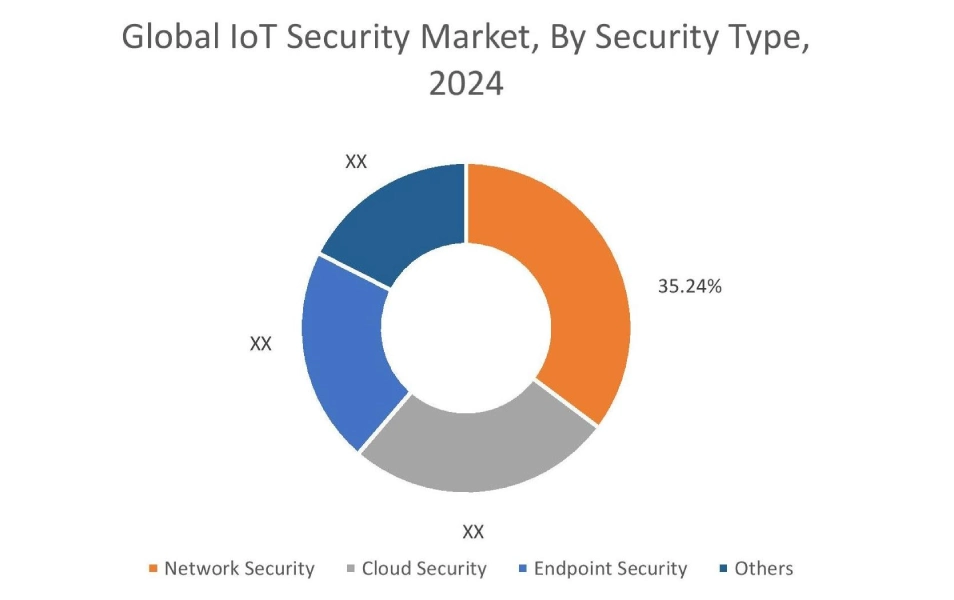
By End-Use:
Based on end use, the market is segmented into manufacturing, BFSI, energy & utilities, government & public sector, healthcare, retail & e-commerce, and others.
Trends in the end use:
- There is a rising trend towards the utilization of IoT (internet of things) security solutions in manufacturing sector for securing both data and physical infrastructure of manufacturing operations, including monitoring, threat detection, and access control.
- Increasing adoption of IoT (internet of things) security in the healthcare industry for protecting patient data and ensuring the reliable operations of connected medical devices is driving the healthcare segment growth.
Manufacturing segment accounted for a substantial revenue share in the overall market in 2024.
- In manufacturing sector, IoT is typically used for applications such as predictive maintenance, asset tracking, quality control, and supply chain optimization, which require robust security measures.
- IoT (internet of things) security solutions play a vital role in the manufacturing sector due to its increasing reliance on connected devices and prevalence of potential risks associated with cyberattacks.
- These solutions primarily involve securing both the data and physical infrastructure of manufacturing operations, including monitoring, threat detection, and access control.
- For instance, Cisco Systems Inc.offers IoT (internet of things) security for the manufacturing sector in its solution offerings, which is designed to facilitate a smart and secure factory and protect manufacturing operations within the IoT network.
- According to the IoT security market analysis, the aforementioned factors are driving the market growth.
The healthcare segment is anticipated to register the fastest CAGR during the forecast period.
- The healthcare sector consists of sensitive information regarding the patients, making it one of the key targets for cyberattacks.
- Few of the major threats that are prevalent in the healthcare sector include data breaches, ransomware, and medical device vulnerabilities, among others.
- Consequently, IoT (internet of things) security solutions are primarily used in the healthcare sector for protecting patient data and ensuring the reliable operations of connected medical devices.
- Additionally, these security solutions address risks such as data breaches, device tampering, and privacy violations, which are crucial for protecting patient information and safety.
- Therefore, the rising adoption of IoT (internet of things) security solutions in healthcare solutions is projected to drive market growth during the forecast period.
Regional Analysis:
The regions covered are North America, Europe, Asia Pacific, Middle East and Africa, and Latin America.
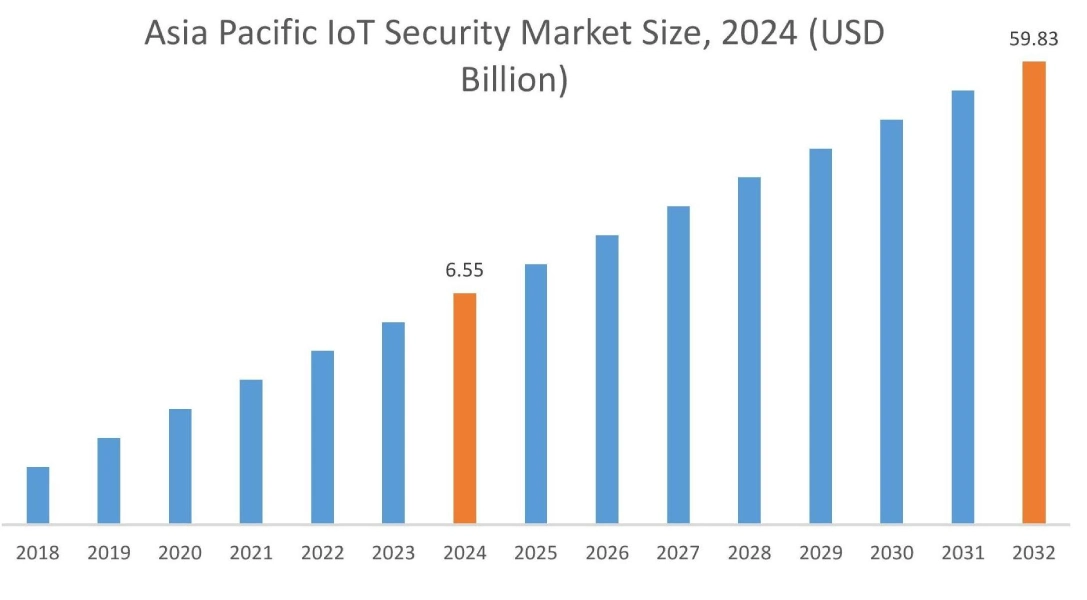
Asia Pacific region was valued at USD 6.55 Billion in 2024. Moreover, it is projected to grow by USD 8.48 Billion in 2025 and reach over USD 59.83 Billion by 2032. Out of this, China accounted for the maximum revenue share of 35.45%. As per the IoT security market analysis, the adoption of IoT (internet of things) security in the Asia-Pacific region is primarily driven by growing manufacturing, retail, and healthcare, and government sectors among others. Additionally, the rising number of data breaches in the government & public sector along with growing need for reliable security solutions for interconnected devices are further accelerating the IoT security market expansion.
- For instance, in July 2022, Shanghai Municipal Police, a government organization based in China, witnessed a data breach that leaked the personal information of approximately one billion Chinese residents from the Shanghai police database stored in the cloud. Thus, the aforementioned factors are anticipated to drive market demand in the Asia-Pacific region during the forecast period.
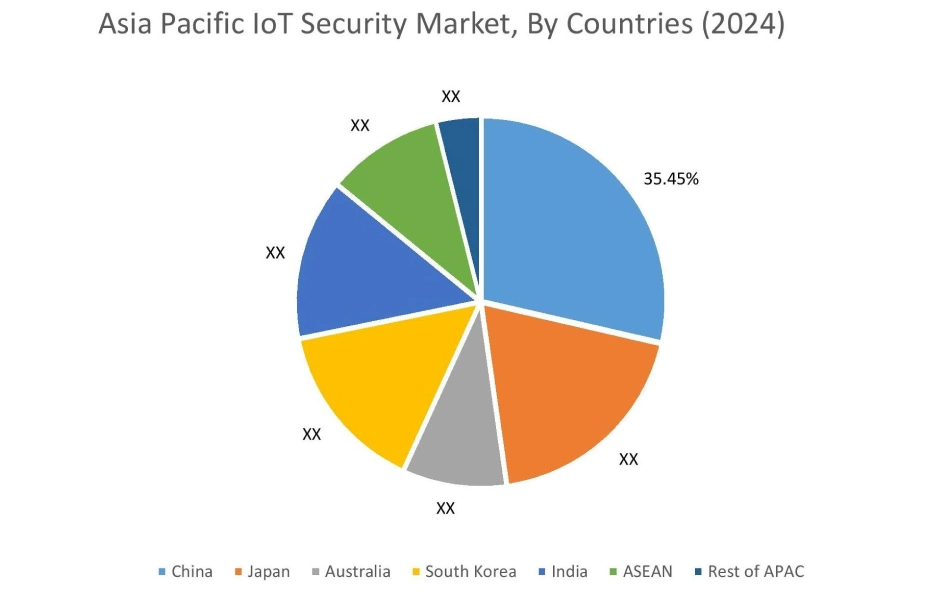
North America is estimated to reach over USD 85.85 Billion by 2032 from a value of USD 9.78 Billion in 2024 and is projected to grow by USD 12.63 Billion in 2025. In North America, the growth of the IoT security industry is driven by growing investments in BFSI, healthcare, retail, and other sectors. Moreover, the increasing adoption of advanced security solutions in BFSI sector for advanced threat protection and improved protection of financial transactions is contributing to the IoT security market demand.
- For instance, in July 2022, Citi Bank launched its new Citi Commercial Bank in Canada, as part of the company’s global extension plan. Citi Commercial Bank offers a wide range of institutional solutions and products to meet the evolving needs of corporates. The above factors are further propelling the market in North America.
Similarly, the regional analysis depicts that the growing healthcare, energy & utilities, retail, and others sectors, combined with the increasing need for reliable security solutions among business enterprises are driving the IoT security market demand in Europe. Further, as per the market analysis, the market in Latin America, Middle East, and African regions is expected to grow at a substantial rate due to several factors such as increasing investments in BFSI sector, expansion of IT firms, and rising need for robust security solutions in government sector, among others.
Top Key Players & Market Share Insights:
The global IoT security market is highly competitive with major players providing solutions to the national and international markets. Key players are adopting several strategies in research and development (R&D), product innovation, and end-user launches to hold a strong position in the IoT security market. Key players in the IoT security industry include-
- Microsoft(USA)
- Fortinet Inc.(USA)
- Thales (France)
- Allot (Israel)
- Atos SE (France)
- Intel Corporation(USA)
- Entrust Corporation (USA)
- Check Point Software Technologies Ltd. (Israel)
- IBM (USA)
- Cisco Systems Inc. (USA)
Recent Industry Developments :
Acquisition:
- In January 2022, Claroty acquired Medigate, a healthcare IoT security company. The acquisition aims at strengthening Claroty’s position in the market by delivering improved operational visibility, threat detection, and protection for all connected organizations through a single comprehensive solution.
IoT Security Market Report Insights :
| Report Attributes | Report Details |
| Study Timeline | 2019-2032 |
| Market Size in 2032 | USD 236.49 Billion |
| CAGR (2025-2032) | 27.1% |
| By Offering |
|
| By Security Type |
|
| By End-Use |
|
| By Region |
|
| Key Players |
|
| North America | U.S. Canada Mexico |
| Europe | U.K. Germany France Spain Italy Russia Benelux Rest of Europe |
| APAC | China South Korea Japan India Australia ASEAN Rest of Asia-Pacific |
| Middle East and Africa | GCC Turkey South Africa Rest of MEA |
| LATAM | Brazil Argentina Chile Rest of LATAM |
| Report Coverage |
|
Key Questions Answered in the Report
How big is the IoT security market? +
The IoT security market was valued at USD 26.87 Billion in 2024 and is projected to grow to USD 236.49 Billion by 2032.
Which is the fastest-growing region in the IoT security market? +
Asia-Pacific is the region experiencing the most rapid growth in the IoT security market.
What specific segmentation details are covered in the IoT security report? +
The IoT security report includes specific segmentation details for offering, security type, end use, and region.
Who are the major players in the IoT security market? +
The key participants in the IoT security market are Microsoft (USA), Fortinet Inc. (USA), Intel Corporation (USA), Entrust Corporation (USA), Check Point Software Technologies Ltd. (Israel), IBM (USA), Cisco Systems Inc. (USA), Thales (France), Allot (Israel), Atos SE (France), and others.
